
We last looked at Lytro’s funny little tube camera a couple of years ago when we sat down with one of the devices during a crowded PR event at 2012’s CES. The camera’s light field capture technology uses a high-megapixel CMOS sensor to record a large amount of “extra” data points over a standard camera CMOS sensor. Rather than using the extra data to pump up the scene’s resolution, the camera instead tries to capture a holistic representation of the rays of light it sees. This, coupled with some software magic, allows Lytro cameras to set or alter a picture’s focus point after the picture has been taken.
Although Lytro’s initial product was small and relatively low-resolution, this July the company will be releasing an updated and vastly improved model: the Lytro Illum. Engadget has posted a lengthy hands-on with the Illum, which sports a sleek exterior that begs to be touched.
via ars technica
Image: Lytro






